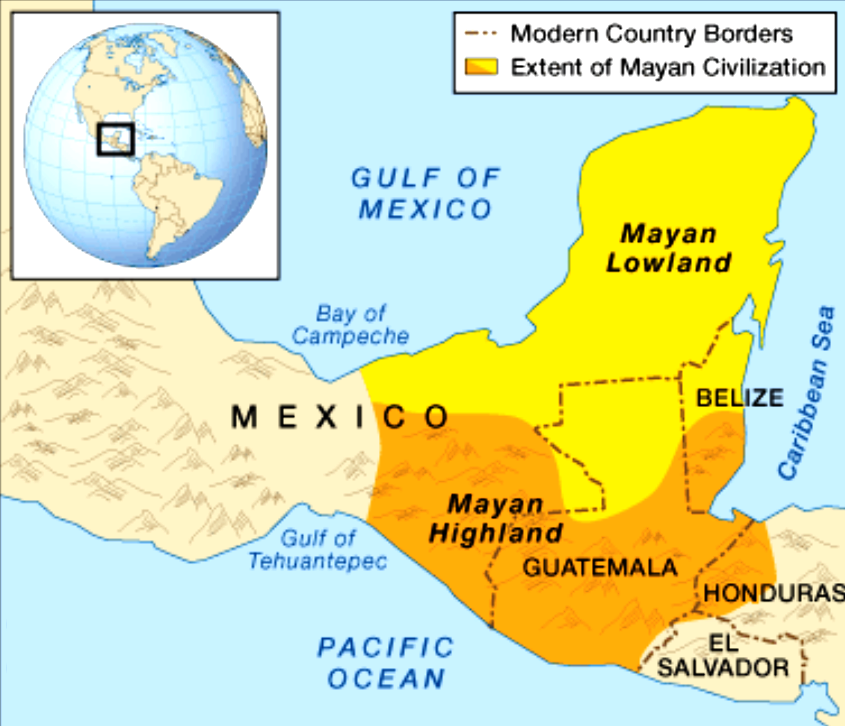Important Facts For Prelims
Maya Technique of Maize Fortification
- 14 Jun 2022
- 5 min read
Why in News?
A study has thrown light on how Maya people fortified their maize with the chemical process known as 'nixtamalisation’ and also built indoor toilets in pits they dug into the limestone bedrock of the Yucatan peninsula in Mesoamerica.
Who were the Mayas?
- The Maya are an indigenous people of Mexico and Central America who have continuously inhabited the lands comprising modern-day Yucatan, Quintana Roo, Campeche, Tabasco, and Chiapas in Mexico and southward through Guatemala, Belize, El Salvador and Honduras.
- The Maya are probably the best-known of the classical civilizations of Mesoamerica.
- The Maya civilization originated in the Yucatan Peninsula. Known for its monumental architecture and an advanced understanding of mathematics and astronomy.
- The rise of the Maya began about 250 CE, and what is known to archaeologists as the Classic Period of Mayan culture lasted until about 900 CE. At its height, Mayan civilization consisted of more than 40 cities, each with a population between 5,000 and 50,000.
- But then, suddenly, between 800 and 950 CE, many of the southern cities were abandoned. This period is called the collapse of the Classic Maya civilisations, puzzling modern-day scientists.
- Special Features:
- As early as 1500 BCE the Maya had settled in villages and had developed an agriculture based on the cultivation of corn (maize), beans, and squash; by 600 CE cassava (sweet manioc) was also grown.
- They began to build ceremonial centres, and by 200 CE these had developed into cities containing temples, pyramids, palaces, courts for playing ball, and plazas.
- The ancient Maya quarried immense quantities of building stone (usually limestone), which they cut by using harder stones such as chert. They practiced mainly slash-and-burn agriculture, but they used advanced techniques of irrigation and terracing. They also developed a system of hieroglyphic writing and highly sophisticated calendrical and astronomical systems.
- The Maya made paper from the inner bark of wild fig trees and wrote their hieroglyphs on books made from this paper. Those books are called codices.
- The Maya also developed an elaborate and beautiful tradition of sculpture and relief carving.
- Architectural works and stone inscriptions and reliefs are the chief sources of knowledge about the early Maya.
What is the Nixtamalisation Technique used by Mayas?
- Nixtamalisation is a method by which the ancient peoples of Mesoamerica like the Maya used to soak and cook their maize in an alkaline solution and make it more palatable, nutritious and non-toxic. Nixtamal is derived from the Nahuatl word nextamalli, meaning ‘nixtamalised maize dough’.
- Maize is the primary crop of the Americas and has been cultivated in the region for millennia. Maize, beans and squash are called the ‘Three Sisters’ and formed the basis of diets throughout pre-Columbian North and Mesoamerica.
- The researchers noted that the key reason for the spread of maize in the Americas was nixtamalisation.
- The process ensures that the maize contains amino acids, calcium and Vitamin B2, which can be utilised by the human body. It also eliminates certain mycotoxins (toxins produced by certain moulds (fungi) and can be found in food) present in maize.
- Without this treatment, maize-dependent populations were at elevated risk of pellagra (Vitamin B2 deficiency), calcium deficiency and mycotoxin poisoning.
- Nejayote, wastewater from nixtamalisation, may have been used to lime the chultunes while they were used as latrines. This was done to control odours and inhibit insect and microorganism growth like it is done today.







